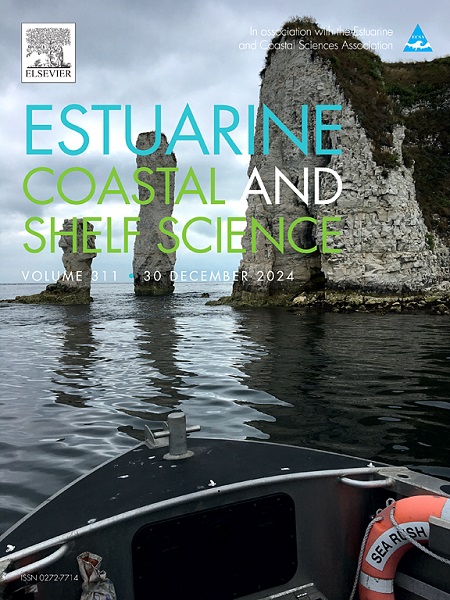Bottom wave streaming intensifies a nearshore upwelling front
IF 2.6
3区 地球科学
Q1 MARINE & FRESHWATER BIOLOGY
引用次数: 0
Abstract
Coastal upwelling front is a crucial physical process on continental shelves, influencing coastal material transport, air-sea interactions, fisheries, and ecological environments. While previous studies have shown that coastal upwelling front is influenced by various factors, such as winds and topography, relatively little attention has been paid to surface waves, particularly bottom wave streaming. Bottom wave streaming is a wave-averaged Eulerian current in the direction of wave propagation, due to bottom friction on waves. It can affect bottom cross-shore transport and vertical mixing, potentially affecting the coastal upwelling front. In this study, we focus on the effects of bottom wave streaming on a wind-driven coastal upwelling front over an idealized continental shelf using a coupled wave-current model. Our results show that bottom wave streaming weakens the along-shelf current through increased momentum dissipation, thereby reducing bottom onshore Ekman transport. As a consequence, less cold, deep water is transported shoreward compared to scenarios without bottom wave streaming. On the other hand, the enhanced vertical mixing associated with bottom wave streaming facilitates the outcrop of bottom cold water, strengthening surface temperature gradients and thereby the upwelling front. Further, sensitivity tests reveal that the bottom wave streaming-induced intensification of upwelling front is robust across different wave directions, heights, and periods. This study highlights the critical role of bottom wave streaming in shaping the nearshore upwelling front, emphasizing its importance in the study of upwelling dynamics and material exchange.
底波流加强了近岸上升流锋面
沿海上升流锋是大陆架上一个重要的物理过程,影响着沿海物质运输、海气相互作用、渔业和生态环境。虽然以往的研究表明,沿海上升流锋受风、地形等多种因素的影响,但对面波,特别是底波流的关注相对较少。底波流是波传播方向上的波平均欧拉流,是由于波与底波之间的摩擦而产生的。它可以影响底部跨岸运输和垂直混合,潜在地影响沿海上升流锋。在这项研究中,我们使用耦合波流模型,重点研究了底波流对理想大陆架上风驱动的沿海上升流锋面的影响。研究结果表明,底波流通过增加动量耗散来减弱沿陆架流,从而减少了底部陆上Ekman输运。因此,与没有底波流的情况相比,较少的冷深水被输送到岸上。另一方面,与底波流相关的垂直混合增强有利于底部冷水的露头,加强了表面温度梯度,从而加强了上升流锋。此外,灵敏度测试表明,底波流诱导的上升流锋面增强在不同的波向、波高和周期上都是稳健的。本研究强调了底波流在形成近岸上升流锋面中的关键作用,强调了底波流在研究上升流动力学和物质交换中的重要性。
本文章由计算机程序翻译,如有差异,请以英文原文为准。
求助全文
约1分钟内获得全文
求助全文
来源期刊
CiteScore
5.60
自引率
7.10%
发文量
374
审稿时长
9 months
期刊介绍:
Estuarine, Coastal and Shelf Science is an international multidisciplinary journal devoted to the analysis of saline water phenomena ranging from the outer edge of the continental shelf to the upper limits of the tidal zone. The journal provides a unique forum, unifying the multidisciplinary approaches to the study of the oceanography of estuaries, coastal zones, and continental shelf seas. It features original research papers, review papers and short communications treating such disciplines as zoology, botany, geology, sedimentology, physical oceanography.

 求助内容:
求助内容: 应助结果提醒方式:
应助结果提醒方式:


